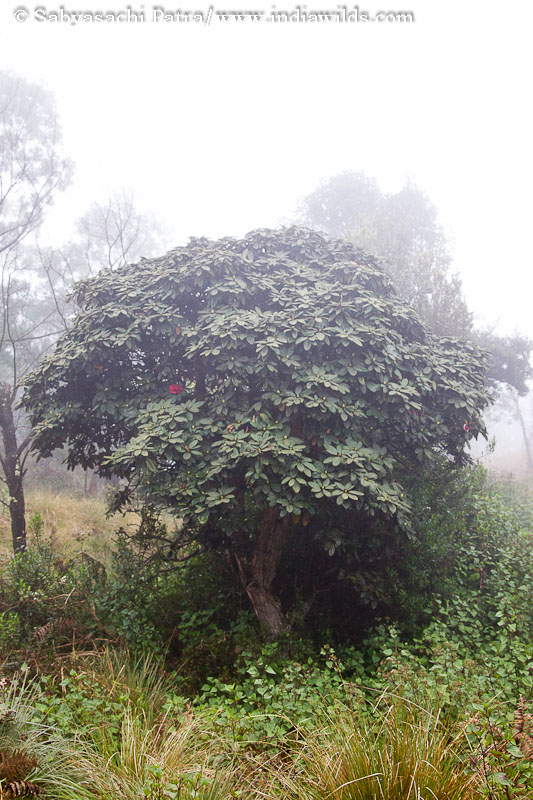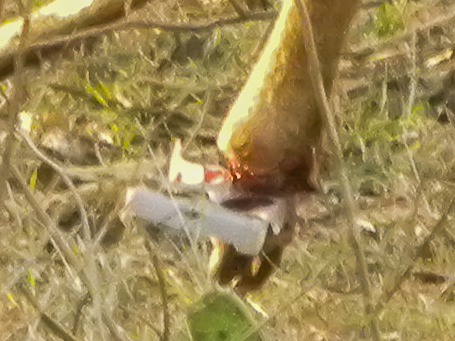IndiaWilds Newsletter Vol. 8 Issue V
Forest Fires
India’s natural heritage is facing an unprecedented assault. Every month there is a new effort to fragment our existing wilderness areas by creating a canal, road, railway line, dam, power plant, politician statue etc. Everyday millions of people enter into the forests in search of wood, Non-timber forest produce, grazing livestock etc. As if this is not sufficient, large swathes of forests are razed to the ground due to forest fires. To make matters worse, not even a tiny fraction of India’s billion plus population come to know about it. Recently the forest fires in Uttarakhand attracted national attention by the sheer magnitude of it and it could easily be comparable to the massive forest fires in USA.
Some estimates suggest 4048 hectares of forest have been burnt due to forest fires in Uttarakhand since the month of February 2016. Other estimates are much higher and the number of fire incidences keep on increasing every day and may cross 2000 by the time the monsoon rains make their appearance. Over 4500 hectares have been impacted by forest fire in Himachal Pradesh.
The forest department mostly talk about the loss of timber from the forests due to forest fires. The impact of forest fires on bio-diversity of these forests is neither studied nor gets any attention.
The British viewed India’s forests as source of wood. Unfortunately, that mentality still remains. It is easy for a new recruit to forest service to understand the value of wood that each tree can provide. It is also somewhat easy to understand the amount of non-timber forest produce (NTFP) collected from our forests. However, the role of our forests in our overall well being is not understood.
Forests and our well being:
Forests are responsible for rains. The moisture from the trees evaporate and help in causing rains. A country, which is increasingly facing drought and its farmers routinely committing suicide, should be more concerned about this role of forests in causing rains.
Forests act as our lungs. They help in carbon sequestration. The chlorophyll of the leaves take in the carbon dioxide from the atmosphere and give back oxygen. This ecosystem service cannot be artificially created and the value of it can run up to billions. When massive chunks of forests are razed to the ground, the impact is tremendous. The forest fires lead to lot of soot and ashes into the air as well as release of carbon dioxide, carbon monoxide, methane, hydrocarbons and various other noxious gases into the air which cause short-term negative impact on the air quality. The loss in ability to take in carbon dioxide from the air and release oxygen due to loss of tree cover results in lower air quality in the long-term. This impact on air quality hasn’t got the deserved attention.
According to the State of Forest 2015 (ISFR 2015), the total forest and tree cover in India is 79.42 million hectares. According to the same report the total carbon stock is 7044 million tonnes. A simple rule of thumb calculation taking an average carbon stock per hectare of forest and tree cover comes to 88.69 tonnes. So the initial estimates of 4048 hectares of forest burnt in Uttarakhand since February 2016 comes to 3.59 lakh tonnes or 0.359 million tonnes of carbon stock lost. The total impact on carbon stock of India due to forest fire would be massive. However, this rule of thumb calculation is just an approximate as different tree and plant species have a different ability to fix carbon and their age also matters. Some species like mangroves have roughly four times more capacity than other species. Nevertheless if the ISFR report can also publish this impact then it would be a big help in highlighting the massive problem of forest fires.
It would also be pertinent to mention that the INDC target for forestry sector envisages creation of additional carbon sink of 2.5 to 3.0 billion tonnes of CO2. If our forest fires continue in this manner than this target is going to be missed by a wide margin.
The forests also play a big role in binding the soil together. Without the forests all the top soil would have been eroded in no time by the play of rain and wind. In the hilly districts like Uttarakhand, Himachal, Kashmir, north east and other states, without the forest cover the areas would be prone to landslides.
India’s North-East states (Arunachal Pradesh, Assam, Manipur, Meghalaya, Mizoram, Nagaland, Sikkim and Tripura) have lost a total of 628 square kilometres of forests. Another hilly state of Uttarakhand has already lost 268 square kilometres of forests. Karnataka in South India which has a large portion of Western Ghats has lost 195 square kilometres of forest cover (ISFR 2015). Excluding the portion illegally occupied by Pakistan and China, Jammu & Kashmir has also lost 49 square kilometres of forest cover. It is not know how much of these is due to forest-fire. However, the soil erosion leading to landslides are evident in most of these states and the loss in carbon sequestration is huge.
The total loss of forest cover in India above an altitude of 1000 meters is 550 square kilometres (ISFR 2015, table 2.11).
Forest Cover in Altitude Zones in Sq. Kilometers
| Altitude Zone | VDF
(Very Dense Forest) |
MDF (Moderately Dense Forest) |
OF
(Open Forest) |
Total | Change w.r.t.
ISFR 2013 in Sq. Km |
| 1000-2000m | 14,867 | 36,536 | 24,971 | 76,374 | -109 |
| 2000-3000m | 14,011 | 19,013 | 7,417 | 40,441 | -279 |
| 3000-4000m | 3,353 | 7,934 | 5,962 | 17,249 | -100 |
| Above 4000m | 36 | 292 | 562 | 890 | -62 |
Forests are our Jewels as they are vital for our economy, society and the well being of us and hence need to be preserved.
The raging forest fires raise-up the temperature of the place. And in places like Uttarakhand, it won’t be surprising if this leads to untimely melting of glaciers. Unfortunately there are more issues to be examined than there are scientists and funding agencies, so one can’t get sufficient statistical data to convince the decision makers.
Forest fires when uncontrolled can also lead to lot of deaths of animal, bird, reptile and other species including people. Animals that are sick, old, injured and young as well as herpetofauna get burnt alive in these forest fires.
Unfortunately, the forest fires don’t get sufficient attention. Unlike countries like USA and Canada where they routinely plan tackling forest fires with latest equipment and trained work force, most of the times in India either we fight a half-hearted battle due to lack of resources, fight with untrained volunteers or completely give up and hope for the forest fire to die down on its own.
In the recent forest fires in Uttarakhand and in Jammu near Vaishnodevi shrine, MI-17 helicopters of the Indian Air Force were deployed to tackle the forest fire. These helicopters carried water and poured over the forest fires. Vaishnodevi shrine workers volunteered to douse the fire along with the forest department staff.
Forest-fire suppression is high priority globally:
As opposed to India where the IAF had to depute some of its helicopters to help in fighting forestfires, there is dedicated staff and aircraft for fighting forest fires. The US Forest Service has contracted operators who maintain 23 heavy air tankers. These aircraft are equipped with fire retardant chemicals to douse the fires. These fire retardants are given a particular colour so that they can easily identify the areas where the fire retardants are dropped. The evolving technology in fire retardants these days have ensured that the fire retardants can act as a fertiliser for help in regrowth of plants after the fire. The total amount of funds earmarked for fire suppression in US for the year 2017 is $873.9 million dollars.
Since the present prime minister of India, Shri Narendra Modi, appeared to have a first name basis relation with President Obama of USA, I am sure he may also like to burrow a leaf from the US President’s policies. Shri Modi has also asked people to store rain water this year for difficult times ahead. Given the role of forests in causing rain, carbon sequestration, NTFP and fighting climate change Modi ji’s Government should focus on increasing our forest fire fighting ability.
According to scientists as long there has been forests, there has been forest fires. When the forest gets burnt down, the grasslands take over. And then slowly with the dispersal of seeds by birds, herbivores and by natures agents trees come up. This process of conversion of forests to grasslands and vice-versa happens over decades. Over a period of time the forests have evolved and some species have more fire resistant capabilities. If we look at forests which have less intervention of man, for example the shola forests, the outer periphery of these forests have trees like rhododendron which are more fire resistant compared to others.
Unfortunately, with the hand of man, the natures balancing mechanism is broken. The relentless pace at which man disrupts ecosystems is too difficult for nature to handle. The composition of our forests are changing. We have introduced exotics as well as monoculture, so when there is fire all the trees catch fire at one go. When the forest is composed of a single tree species then all of them shed their leaves at the same time and catch fire at the same pace. If there were different trees which can withstand different fire to different degrees then the fire would not have spread so fast. Like a big army relentlessly firing and marching together these forest fires spread like a big wall. So it becomes very difficult for the fire fighters as there are no pockets in between where they can stand and fight.
Do we care?
The recent Uttarakhand fires caught national attention after a long time. As usual the mainstream media is isolated from the happenings in the rest of the country. At times people are shocked to find some forest officers non-challantly going about their daily routine despite their forest being on fire.
The fact is that most of the protected areas are incapable of fighting forest fires as they lack trained manpower and equipment. With a lot of positions vacant and the existing manpower being old and demotivated, it is not easy to goad your ill-equipped and demotivated staff to fight forest-fires which can also be life threatening to the fire-fighters. With the rise in tourism, the forest department officials are busy monitoring the tourism activities as the tourism revenue becomes an indicator of the success of their department and swells their wallet as well. There was a time when forest fires, though feared were contained due to careful creation of firelines and able fire-fighting and prevention efforts. Unfortunately, these days the routine patrolling and forest management activities are the lowest priority in most of the forests.
Most Forest Fires are man-made:
When forest fire prevention and suppression is not the top most issue in the minds of the forest department officials, it is natural that reasons for all the forest fires are properly investigated. Despite the weak data on reasons for forest fires, it is estimated that more than 95% of all the forest fires are caused by people.
At times miscreants purposefully set a forest on fire. In one of the premier national parks, a tigress with small cubs had killed a cow inside a village which was resisting relocation due to procedural issues. The villagers set fire the forest even when the field director and rangers and all staff were hardly a kilometre away. There was no mechanism to fight the fire and next day morning I saw a huge areas burnt. The fire had jumped the firelines in many places and burnt down massive areas. In the summer of 2014 miscreants in a coordinated manner burnt down close to 900 hectares in Bandipur National Park and Nagarhole National Park in Karnataka and the adjoining Wayanad Wildlife Sanctuary in Kerala. Some parts of Mudumalai National Park bordering Bandipur was also burnt.
Forest fires also happen by accident when people throw away their cigarettes and beedis while grazing cattle. Most of the times the people knowingly set fire to the undergrowth during the dry season as this will lead to new grass sprouting after rains so that their cattle can then graze in these areas. These fires which just start as a Surface Fire spreading on the ground can become get converted to a Crown Fire where the crown of shrubs and trees also burn. This happens when the forest is very dry in the later parts of Summer with lot of dry bushes and dried leaf litter in the ground. In hilly areas in the North and North East states with coniferous trees, the resins from the trees fuel the fire and it can immediately become a raging inferno going out of control burning the entire forest including old growth trees as well as the undergrowth. As long as cattle grazing and other anthropogenic activities like wood cutting happens in our forests, the chances of fire remains.
Poachers light fire to a patch of forest and wait at the other end near a game trail for the deers, sambars and other herbivores to appear. This is a favourite tactics in many forests throughout India. Poaching happens when there is lack of patrolling in the forests. Poaching also happens at times with the connivance of the staff. When the park managers have good intelligence gathering system and motivated field staff, then poaching incidents reduce.
Role of Forest Department after Forest Fire:
Even after a forest has been burnt down, there is an important role for the forest department. In India, roughly about 13 million hectares of land has been lantana infested. Similarly there are also other invasive weeds which cause tremendous losses to the ecosystem and has a major impact on our economy. Lantana causes crop loss to the tune of $37.8 billion dollar per year. The pasture losses due to lantana is $924 million US dollars per year. (IndiaWilds Newsletter Vol. 7 Issue VII http://www.indiawilds.com/diary/indiawilds-newsletter-vol-7-issue-vii/ ). So when a forest is burnt due to fire, the forest department should immediately start plantation of native tree saplings. It is important to plant saplings instead of sowing seeds because lantana reduces germination. This will help in reclaiming the forest land from invasives.
The forest department can rope in NGOs and can take the help of MGNREGA scheme to provide jobs to local people for the tree plantation in the area, weed removal etc.
Forest fire is a national disaster as in one stroke hundreds and thousands of hectares of forests are gutted. Forests are our wealth and impacts our well being so we have to protect our natural wealth from disasters. However, forest fire is not like any other national disaster as it requires specific knowledge, training and equipment to suppress as well as prevent its occurrence. The Government has to come out with a national level plan to fight forest fires throughout India. If the Government is serious about saving Wild India, then adequate resource allocation has to be done to create a Forest Fire Management Authority specifically to fight wild fires.
References:
ISFR 2015: http://fsi.nic.in/isfr-2015/isfr-2015-forest-cover.pdf
Conservation News
Lower Orr Dam gets Green Clearance
The Lower Orr dam project in Madhya Pradesh has got the green clearance by an expert panel of MoEF&CC. The Lower Orr dam project is scheduled to come up on the Orr River, a tributary of Betwa. The Orr project will be done by the Madhya Pradesh State Government. When the Ken-Betwa river linking project gets the final go-ahead, the Lower Orr dam project will become a part of it.
The Orr dam project will come up Didauni village and is meant to provide water supply for domestic as well as agricultural needs in Shivpur and Datia districts of MP. This project will take up huge land to the tune of 3730 hectares.
The river linking proposal between Ken and Betwa (http://www.indiawilds.com/diary/panna-drowning-fears-of-a-volunteer/)has been contentious as the EIA hasn’t been done in a holistic manner. The nature of Ken and Betwa and all their tributaries have not been taken into consideration for the river linking project. Else the project would have been a non-starter. However, when the Ken-Betwa river linking project is yet to be decided, the clearance given to the Orr dam which is on the tributary of Betwa and completely dependent on it is strange. Without Ken-Betwa the feasibility of the Orr dam is doubtful. Perhaps it is assumed that the Ken-Betwa is a done deal and hence the EAC given to the Orr dam.
Modi Govt. to come up with new Western Ghats Policy
Shri Prakash Javadekar, Hon’ble Minister for MoEF&CC announced that the Narendra Modi Government would create a new policy to conserve the Western Ghats. He said that “The Centre will formulate a policy that will conserve the rich biodiversity of the area, at the same time ensuring that the livelihoods of 5 crore people residing in the region spread across Gujarat, Maharashtra, Goa, Karnataka, Kerala and Tamil Nadu are not adversely affected.”
He further said that “It is a myth that ecological conservation and development cannot co-exist. It is not correct to see environment and development as being two ends of a spectrum, where one must be compromised in order to enhance the other”.
Since the last few years there is a big tussle going on for the Western Ghats. The UPA Government created the Western Ghats Ecology Expert Panel (WGEEP) chaired by Prof. Madhav Gadgil. The Gadgil committee report was criticised because it gave emphasis to the environment and there were protests Facing these protests in Kerala where its own party was in power as well as protests from others the UPA Govt. at the centre created the Kasturirangan Committee which watered down the strong environmental protection focus of the Gadgil committee report (http://www.indiawilds.com/forums/showthread.php?13377-No-protection-to-63-of-Western-Ghats-is-perilous). However, there were protests in Kerala fuelled by certain Christian organisations (http://www.indiawilds.com/forums/showthread.php?13606-Church-opposes-Kasturiranjan-report ). With the announcement by the Minister that a new policy on Western Ghats is likely in the near future, the last word on this is yet to be said. With each passing day Western Ghats continues to bleed.
110 Indian One Horned Rhinos have died in Zoos
110 Indian one horned rhinos have died in Indian zoos in 50 years between 1965 to 2015. This statistics has been compiled by BM Arora former Principal Scientist in IVRI and current president of the Association of Indian Zoo and Wildlife Veterinarians. The maximum age of an Indian rhino in zoo is 47 years.
The major deaths were in the age group of 11 to 30 years (38.9%) followed by the age group 0-3 years (34.26%). 63 out of the 110 rhinos who died were males. “From the year 1965 to 2015, the highest mortality was reported in 1982 as seven rhinos had died in zoos across the country. Five deaths were reported in 1999 and 2007 each while two to four rhinos died in remaining years”.
Rhinos are an endangered species and each death is important. When the 110 rhino deaths were analysed it was found that only 34 of these 110 rhinos were born in the zoos. Rest of the 76 rhinos were captured from the wild and then died untimely deaths in the zoos.
The study finds that some of the deaths were due to diseases as well as natural causes. However in most of the cases, the reason of death is still need to be investigated. This shows the zoos in very poor light. Our wild rhinos are captured from the wild reducing the genetic diversity in the wild and then these endangered rhinos die in the zoo but no one cares to investigate and take action.
Our zoos have outlived their utilities. The preamble of National Zoo Policy states “Today when wildlife habitats are under severe pressure and a large number of species of wild fauna have become endangered, the zoos have not only to sustain their own populations but also augment the depleting populations of endangered species in the wild.” Unfortunately, instead of serving as breeding grounds for endangered species for populating them in the wild, endangered wildlife captured from the wild are dying in the zoos. For more: http://www.indiawilds.com/forums/showthread.php?109-Abolish-Zoos
Know Your Plants
Memory in Plants
People who believe that plants do not have life need to take notice of this. One of the reasons people believe plants to be different than animals is because animals do have memory and consciousness. A recent study published in Proceedings of the National Academy of Sciences (Luminidependens (LD) is an Arabidopsis protein with prion behavior, Charabortee et all, PNAS 2016 113 (21) 6065-6070) suggests that plants may have indeed proteins, which behave like prions and are capable of building molecular memory. Prions are found in mammals, insects and yeasts.
Prions were first discovered in mammals and since then they have been found in a variety of organisms like fungi, Aplysia, Drosophila etc. however, till date they had not been found in plants.
The researchers used the methods that helped them successfully uncover prions in yeast identified close to 500 Arabidopsis proteins which they suspected to have potential prion-like domains (PrDs). Out of these they found one domain Luminidependens PrD, which has some of the classic characteristics of prion proteins. The researches feel that this is a prion-like protein because Luminidependens PrD is involved in the flowering process which takes into account several internal and external cues like very cold winter etc for regulating the flowering process. According to the researchers “We investigated the prion-forming capacity of three prion candidates involved in flowering using a yeast model, where prion attributes are well defined and readily tested. In yeast, prions heritably change protein functions by templating monomers into higher-order assemblies. For most yeast prions, the capacity to convert into a prion resides in a distinct prion domain. Thus, new prion-forming domains can be identified by functional complementation of a known prion domain. The prion-like domains (PrDs) of all three of the tested proteins formed higher-order oligomers. Uniquely, the Luminidependens PrD (LDPrD) fully replaced the prion-domain functions of a well-characterized yeast prion, Sup35. Our results suggest that prion-like conformational switches are evolutionarily conserved and might function in a wide variety of normal biological processes”.
This is going to start a new line of research and soon we should get many more interesting facets about the plant kingdom. It would be pertinent to mention that some of the trees live for hundreds of years, many times the lifespan of a human. These days by looking at the thickness of the cores in the trunk of a tree one can find out the years there was a severe winter or drought etc.
Trees shed leaves to restrict water loss. Some perennial plants and trees not only shed their leaves but also whole branches. When there is rain the dormant buds come alive and start growing leaves. Seeds of some annual flowering plants can remain dormant in the sand in desert for years. A study of Karoo flora found 34,200 viable seeds per square yard in the top three inches of the sandy soil. Their trick is to germinate with the first rain, grab available nutrients (actually more plentiful in dry sands than in humid soils, where nutrients are tied up in organic matter), mature, and set seed as quickly as possible (Africa by John Reader, National Geographic publication). So even the seeds may retain some memory so that with the first rains they have to outcompete other seeds to germinate. Memory of such incidences stored as molecular memory is an exciting topic. At the very basic we understand that the plants respond to such external environmental stimuli resulting in delay of flowering. However, are there any higher order of use of such memory?
We know that the plants kind of communicate with each other. For example, when a giraffe eats the leaves of the acacia plant, the acacia immediately sends tannins to the leaves which leave a bad taste in the mouth. If the giraffe continues to consume the leaves then the level of tannin can build up to lethal proportions. So the giraffe immediately moves to another plant. However, the acacia also emits ethylene gas, which wafts on the air and reaches other acacia trees and they in turn immediately start producing tannin. So this release of ethylene gas helps in communicating between the acacia trees about the danger of approaching predators. Since the plants communicate with each other to warn the approach of danger, do they also guide the youngsters in their community like some humans do? Does a big old tree tell a younger tree about the approaching harsh winter and suggests the younger one, which is to flower for the first time that year, to delay flowering?
I am sure many such questions will be explored in the future by scientists to help us learn and appreciate the life of plants and trees.
Conservation Imagery
Wasting life
By Dr. Jean-Philippe Puyravaud, Sigur Nature Trust
In the March 2016 issue of the IndiaWilds newsletter (http://www.indiawilds.com/diary/indiawilds-newsletter-vol-8-issue-iii/) , there was an article saying that 15,000 tonnes of plastic waste is generated every day in India, out of which 9,000 tonnes is collected and processed, but 6,000 tonnes of plastic waste is not being collected. It shows that for a variety of reasons, institutions in charge of waste management are by and large, incompetent. However, it gets worse.
If you visit protected areas, you will have noticed the huge quantity of plastic waste left behind by tourists. In the Sigur Region, in the heart of the Nilgiris Biosphere Reserve, the road in between the Mudumalai Tiger Reserve and Ooty is littered with bottles, plates, bags. In theory, there is no waste management to organize, except maybe once a year, because people are not supposed to throw waste in protected areas. Not only is it against the law, but it appears to go against common sense.
I am not convinced littering is a question of education only. Yes, there are people who still don’t know what a waste bin is. But most of the people who throw waste in Sigur are sufficiently educated, some in expensive cars, and I believe that many of them, the majority probably, have voted to have a cleaner country. Unfortunately they still expect some staff –in the jungle– to clean up their mess.
Actually, the trash is picked up, but not by the rare and understaffed patrols. Those who collect plastics are elephants, deers, cows and birds who die of intestinal occlusion.

Cheetal Axis axis deer munching a plastic packet of wafers in Bandipur Tiger Reserve, India. Deers often munch and swallow empty wafers packets carelessly thrown away by tourists and the deers are also known to be killed in the process.
However, plastics can kill even when not ingested by animals. I witnessed that plastics can form traps around the legs of animals. Recently, I saw a cheetal that had managed to put its leg though a plastic sheet pierced with large holes. The holes were sufficiently large to allow the hoof to become trapped, but not large enough to let the animal escape. After days with this contraption, the plastic sheet had lacerated the leg and this animal will soon die in cruel agony.
Since everyday roughly 6000 tonnes of plastic waste remains uncollected, the chances of wild herbivores having their hooves stuck in plastic are increasing everyday. Unless we change our ways, this may become an everyday sight in the not too distant future.
IndiaWilds App for Android Mobile
In India most of the internet penetration is happening through mobile phones. And the existing users who have access to desktops and laptops are becoming much more mobile then they used to be a few years ago. So to raise awareness and reach out to more people we need to adapt ourselves and make IndiaWilds easily accessed through a mobile phone using android OS.
We have created a mobile phone app so that people can access IndiaWilds anytime, anywhere without being tied to a computer. No need to type. One can access at the click of a button.
We have developed this app through Business Compass LLC a company based in Randolph, New Jersey, United States so that we create a good app.
Awareness is the first step before a person can become a champion of wildlife. I hope this will help us in reaching out to more people to raise awareness and make a real impact on the conservation landscape. If you have an android device then please download the app from this link:
https://play.google.com/store/apps/details?id=com.businesscompassllc.indiawilds
Equipment Discussions
Canon EOS 1DX Mark II Review
Introduction:
The Canon EOS 1DX Mark II was one of the most awaited flagship DSLR cameras to hit the market in the recent times. Following is the hands on impression of the EOS 1DX Mark II camera. This is more of an evolving review and you will find this review to be updated many times as I continue to put it to test in a range of situations.
For more details check the below link –
SanDisk becomes Western Digital Brand
Western Digital completes acquisition of SanDisk and becomes global Storage Tech leader
Western Digital® Corporation has completed the acquisition of SanDisk Corporation. This $19 billion acquisition was announced in October 2015 following which Western Digital has now secured all regulatory approvals and financial closure of this deal.
With the completion of this acquisition Western Digital has become a storage solutions company with global scale. The combined entity will have about 74,000 employees. Its market is going to be double and it will help enter into higher growth segments. SanDisk, which has a large customer base in India and is highly popular among the photographers and filmmakers will help Western Digital with its solid state technology. The solid state drives (SSDs) are increasingly becoming cheaper and being offered in laptops as well as being used for recording in high end cameras and monitor recorders. Western Digital badly needed long-term access to SSD technology at a cheap cost to remain competitive and it will now be able to achieve it with this acquisition of SanDisk.
Western Digital also is the owner of G-Tech which is popular for its G-RAID and hard drives. Though Western Digital has said that SanDisk will remain as a brand, however all the brands are expected to benefit from each other’s technology. Given the scale of the M&A between these companies the integration should take at least a year and more for the customer to find visible changes.
Press Release of Western Digital:
Western Digital Completes Acquisition of SanDisk, Creating A Global leader In Storage Technology
IRVINE, Calif. — May 12, 2016 — Western Digital® Corporation (NASDAQ: WDC) today announced that its wholly-owned subsidiary Western Digital Technologies, Inc. has completed the acquisition of SanDisk Corporation (NASDAQ: SNDK). The addition of SanDisk makes Western Digital Corporation a comprehensive storage solutions provider with global reach, and an extensive product and technology platform that includes deep expertise in both rotating magnetic storage and non-volatile memory (NVM).
The Company also indicated that the debt financing associated with this transaction has been consummated and that the previously obtained funds from this financing have been released from escrow to Western Digital Technologies, Inc.
“Today is a significant day in the history of Western Digital,” said Steve Milligan, chief executive officer of Western Digital. “We are delighted to welcome SanDisk into the Western Digital family. This transformational combination creates a media-agnostic leader in storage technology with a robust portfolio of products and solutions that will address a wide range of applications in almost all of the world’s computing and mobile devices. We are excited to now begin focusing on the many opportunities before us, from leading innovation to bringing the best of what we can offer as a combined company to our customers. In addition, we will begin the work to fully realize the value of this combination through executing on our synergies, generating significant cash flow, as well as rapidly deleveraging our balance sheet, and creating significant long-term value for our shareholders.”
The integration process will begin immediately through the joint efforts of teams from both companies. As previously announced, Steve Milligan will continue to serve as chief executive officer of Western Digital, which will remain headquartered in Irvine, California. Sanjay Mehrotra, co-founder, president and chief executive officer of SanDisk, will serve as a member of the Western Digital Board of Directors, effective immediately.
“As a combined company, we will be best positioned to address the demands for data storage, which is growing exponentially every year,” said Sanjay Mehrotra. “Growth and change go hand in hand, and we couldn’t be happier to grow and change together with Western Digital. I look forward to contributing to realizing the potential of this combination as a member of the board.”
Under the terms of the transaction, each outstanding share of SanDisk common stock was converted into the right to receive $67.50 per share in cash and 0.2387 shares of Western Digital common stock.
Natural History
COUNTRY NOTEBOOK: M. Krishnan: ‘DRACO-Flying Lizard‘ By Saktipada Panigrahi
http://www.indiawilds.com/forums/showthread.php?8852-Country-notebook-m-krishnan&p=79167#post79167
Method of Food Collection by male speckled piculet By Samrat Sarkar
Black-winged stilt mating ritual by Vipin Sharma
http://www.indiawilds.com/forums/showthread.php?17397-Black-winged-stilt-mating-ritual
Wildlife Photography
Prowl by Prashobh Ailyam Nair
http://www.indiawilds.com/forums/showthread.php?17460-The-Prowl
Leopard from Bera by Vipin Sharma
http://www.indiawilds.com/forums/showthread.php?17461-Bera-Leopard
Variable Squirrel by Shyamala Kumar
http://www.indiawilds.com/forums/showthread.php?17409-Variable-Squirrel
Sukhi Patiya female of Bandhavgarh by Debasis Bose
http://www.indiawilds.com/forums/showthread.php?17417-Sukhi-Patiya-female-of-Bandhavgarh
Elephant charging by Ulhas Kalyanpur
http://www.indiawilds.com/forums/showthread.php?17411-Charging-Lady!!
Scops Owl by Abhirup Dutta Gupta
http://www.indiawilds.com/forums/showthread.php?17435-Indian-scops-owl
Sirkeer malkoha displaying by Subhash Shrivastava
http://www.indiawilds.com/forums/showthread.php?17410-Sirkeer-malkoha-displaying-Hampi
Eurasian Blackbird basking by Abhishek Jamalabad
http://www.indiawilds.com/forums/showthread.php?17453-Eurasian-Blackbird
Owl by Prajwal Ullal
http://www.indiawilds.com/forums/showthread.php?17403-The-eyes-of-the-tree
White Throated Munia by Nishith Kumar
http://www.indiawilds.com/forums/showthread.php?17413-White-throated-Munia
Snake with kill by Samrat Sarkar
http://www.indiawilds.com/forums/showthread.php?17447-Snake-with-kill
Star Fish by Anil Kumar Verma
http://www.indiawilds.com/forums/showthread.php?17448-Star-in-Sands-of-Konakn
Orb Weaver by Arun Acharjee
http://www.indiawilds.com/forums/showthread.php?17401-Orb-Weaver
I look forward to your inputs and support in preserving the last tracts of wilderness and wildlife left in our beautiful country. For other interesting articles and images check –http://www.indi
To post in the IndiaWilds forums, you can register free of cost using your Full Name as user id at
http://www.indiawilds.com/forums/register.php
If you are already a member of IndiaWilds and have forgotten your user id and/or password you can mail to
administrator@indiawilds.com
If you want to contribute original articles, or for any image enquiries please send a mail to
administrator@indiawilds.com
Regards,
Sabyasachi Patra
Profile | Contact Us | Facebook | Diary | Equipment reviews | Forums | IndiaWilds You Tube Channel
Please post your views and feedback in the comments below.
- Endangered Wild Buffalo of Kaziranga - 4 July,2024
- Leopards: The Last Stand Trailer 2 - 1 July,2024
- GoPro Hero 12 Black - 6 September,2023















